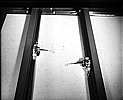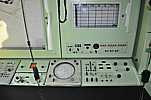IFC Battery Control (original) (raw)
This is where the Battery Commander (or Battery Control Officer) and the Acquisition Operator sat. This was the central command place of the battery. Summations of the status of other places of the battery arrived here, and commands to battery components went out from here.
Visitors could view this area, but only after various charts and documents were covered, such as:
- The main plotting boards often contained diagrams of safe zones, ... visible under the thin transluctent plotting paper.
This is a diagram of the work place. The battery switchboard is just to the right, and the computer cabinets are to the right rear.
Image from Rolf Goerigk
- Plotting board, thin paper & ink, largest ring is 200,000 yds (over 110 miles)
- T1 quick disconnect (T1 was a van that generated simulated aircraft echos and ECM interference for training purposes)
- IFF (Identification Friend or Foe) control panel (the latest version with the Siemens IFF/SIF) (more)
- ACQ control panel - control the LOPAR radar (more)
- HIPAR control panel - control the HIPAR radar (more))
- Precision Indicator (PI) - (expanded view of the PPI -about 22 degrees wide 10,000 yards long)
- also sent to the Target Tracking operators in the Radar Control van - Target Designator Panel - paints a ring and azimuth line to indicate designated target to Target Tracking operators
- Plan Position Indicator (PPI) ("radar scope") more
- Tactical control indicator (more)
- BCC indicator panel (more)
- Vertical plotting board 200 kyds / 100 kft (more)
- Status indicator lights, (White, Yellow, Red, Blue)
- Target detected speaker (to help arouse sleepy operator)
Plotting Equipment
Horz Plot Arms  used green ink used green ink |
Example Nike Ajax tracking |
|---|
from Michael Keller - Nike Hercules -Nov 2017
Practical use of the above charting equipment is provided by the records of a Short Notice Annual Proficiency provided by Earl Close.
From Ted Willes
I was looking at the picture of the Battery Control Van. Didn't the computer operator sit just to the right of the BCO? I recall that he was there to relay azimuth data to the LCT for emergency procedures purposes. The s/w operator was to his right. (Or is my memory even worse than I thought?) As I recall, the BCO was on the MM circut, the ACQ operator on the Command loop, and the computer operator on the tech loop. The BCO had a switch that allowed him to talk on any loop.
Part of the digital modernization (about 1980)
I received these from digitized Italian Nike site, Ramiro Carli Ballola
see Nike Hercules Updates
Now for a little embarrassment - I forgot where I got these images, or who to give credit to -






